Four ways 3D printing will reshape the retail industry
3D printing is changing the world as we know it. Traditional textile manufacturing, costly prototypes, product recall, and even the way we think about architecture, are all being revolutionised by this technology.
While it's easy to see how engineering is changing thanks to additive manufacturing, you may not have realised that there are numerous ways that 3D printing is reshaping the retail industry:
1. More personalised products
Thanks to the ability to print in any colour, shape, or size, retailers can now offer a much more personalised shopping experience.
Retailers can now create unique products for each individual customer using carbon 3D printers. This not only increases customer satisfaction, but also encourages customers to return to your store for future purchases.
There are many ways to personalise your products using additive manufacturing. One of the easiest is through colour customisation: for example, you could offer customers the option of ordering a custom coloured coffee mug or t-shirt.
As additive manufacturing technology continues to evolve, we can expect even more retailers to offer personalised products that are unique to each customer.
2. Faster production times
In many cases, additive manufacturing can produce products in minutes or hours that would normally take days or weeks using traditional methods. Due to this speed, retailers won't need to stockpile inventory, and they'll be able to create products on demand.
This is especially beneficial for small businesses that may not have the resources to wait weeks or months for a product to be manufactured.
This means that retailers can now quickly respond to trends and changing customer needs without worrying about running out of stock or having too much left over at the end of each season.
3. Reduce costs
Additive manufacturing also allows retailers to reduce costs by eliminating the need for expensive molds and tooling. In addition, additive manufacturing can often be used to create products that are less expensive to produce than traditional methods.
For example, a retailer could print out a prototype for free and then run it through its design process to ensure that the final product will meet all of their needs before production begins.
This means retailers won't need as much money upfront capital, which allows them to reinvest those funds into other areas of their business such as marketing or research and development.
4. Increased competition
As additive manufacturing becomes more popular, we can expect to see an increased number of businesses begin using this technology.
This will create even more competition for retailers and cause them to strive for higher quality products and faster production times.
In order to stay competitive, retailers will need to find ways to differentiate themselves from the rest of the pack. This may include creating unique products or offering personalised services to customers that can't be found elsewhere.
The increased competition will also force retailers to keep prices low in order to remain profitable, which will benefit consumers by increasing access to affordable goods and services while lowering overall costs across industries.
Additive manufacturing is reshaping the retail industry in many ways, and this is only the beginning.
As the technology continues to evolve, we can expect even more changes in the way products are designed, produced, and sold.










Continue reading…